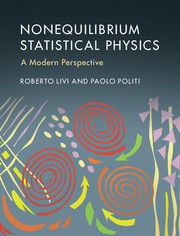Nonequilibrium Statistical Physics
Statistical mechanics has been proven to be successful at describing physical systems at thermodynamic equilibrium. Since most natural phenomena occur in nonequilibrium conditions, the present challenge is to find suitable physical approaches for such conditions: this book provides a pedagogical pathway that explores various perspectives. The use of clear language, and explanatory figures and diagrams to describe models, simulations and experimental findings makes the book a valuable resource for undergraduate and graduate students, and also for lecturers organizing teaching at varying levels of experience in the field. Written in three parts, it covers basic and traditional concepts of nonequilibrium physics, modern aspects concerning nonequilibrium phase transitions, and application-orientated topics from a modern perspective. A broad range of topics is covered, including Langevin equations, Levy processes, directed percolation, kinetic roughening and pattern formation.
- Provides step-by-step calculations so readers can follow the mathematics easily
- A supporting website will provide additional material to accompany the book
- The logical and pedagogical organisation of the book, with clear language, means that readers can approach the progressive levels of difficulty in the book
Reviews & endorsements
Advance praise: ‘Statistical physics has grown over the past few decades’ way beyond its original aims for the understanding of gases and thermal systems at equilibrium, and it is hard to agree on its precise scope, let alone to write a definitive textbook on the subject. [This book] succeeds remarkably well in this task. Cutting a broad swath through the many ramifications of statistical physics in recent times, the book includes a comprehensive review of the many techniques and paradigmatic systems that have come to be regarded as standards of the field. Having solidly covered these essentials, in the third and last part of the book the authors discuss a smorgasbord of topics, from coarsening and kinetic roughening, to pattern formation, to phase-ordering phenomena, selected from their decades of research and expertise in these areas. The book is ambitious and rather comprehensive in its scope. The explanations are succinct and crystal clear, making the volume valuable not only as a textbook but also as a reference work that is sure to become ubiquitous on the shelves of students, teachers, and of young and well-seasoned researchers alike.' Daniel ben-Avraham, Clarkson University, New York
Advance praise: 'Nonequilibrium statistical physics provides the foundation for a plethora of interdisciplinary applications throughout the natural sciences, and courses on this subject are therefore becoming an integral part of physics curricula all over the world. Livi and Politi systematically build up the material from the fundamentals of stochastic processes and linear response theory to current research topics, and explain every step in the most pedagogical and transparent manner. This carefully crafted textbook is certain to become a standard reference for years to come.' Joachim Krug, University of Cologne
'The most elementary equilibrium theory is the one typically taught in undergraduate courses, while the more advanced non-equilibrium theory is usually left for postgraduate courses, whenever the opportunity to teach it exists. However, there are rather few textbooks on the field, and the existing ones are somewhat specialised. Thus, the arrival of this book is highly welcome since this is certainly a textbook on the subject primarily designed for students. … The textbook is written with a pedagogical style and the authors have paid much attention to just mentioning certain key ideas, avoiding a detailed description that certainly would go beyond its scope. … The textbook can be highly beneficial for acquiring a good picture of non-equilibrium statistical physics. It can be used for different purposes, and the contents can be adapted to different levels of students.' Miguel A. F. Sanjuán, Contemporary Physics
'Livi and Politi have set themselves the goal of presenting the derivations in their book as fully as possible and well comprehensible for students, which they overall succeed in. With skill, they choose the most transparent and pedagogically efficient access for each topic. The numerous appendices are also very useful, in which mathematical bases such as the central limit theorem or functional derivatives are treated as well as further topics, such as the renormalization of the Kardar-Parisi-Zhang equation. At the end of each chapter, the authors give annotated bibliographic references to monographs and reviews on the respective topic areas. With this textbook, the authors make an important contribution to establishing and canonising the statistical physics of non-equilibrium as one of the liveliest areas of theoretical physics. Therefore, I wish the book many readers and users.' Joachim Krug, Translated from Physik Journal
Product details
October 2017Hardback
9781107049543
434 pages
253 × 192 × 23 mm
1.12kg
111 b/w illus. 6 tables
Available
Table of Contents
- Preface
- Acknowledgements
- Notations and acronyms
- 1. Brownian motion, Langevin and Fokker–Planck equations
- 2. Linear response theory and transport phenomena
- 3. From equilibrium to out-of-equilibrium phase transitions
- 4. Out-of-equilibrium critical phenomena
- 5. Stochastic dynamics of surfaces and interfaces
- 6. Phase-ordering kinetics
- 7. Highlights on pattern formation
- Appendix A. Central limit theorem and its limitations
- Appendix B. Spectral properties of stochastic matrices
- Appendix C. Reversibility and ergodicity in a Markov chain
- Appendix D. Diffusion equation and random walk
- Appendix E. Kramers–Moyal expansion
- Appendix F. Mathematical properties of response functions
- Appendix G. The van der Waals equation
- Appendix H. The Ising model
- Appendix I. Derivation of the Ginzburg–Landau free energy
- Appendix J. Kinetic Monte Carlo
- Appendix K. Mean-field phase diagram of the bridge model
- Appendix L. The deterministic KPZ and the Burgers' equation
- Appendix M. The perturbative renormalization group for KPZ: a few details
- Appendix N. The Gibbs–Thomson relation
- Appendix O. The Allen–Cahn equation
- Appendix P. The Rayleigh–Bénard instability
- Appendix Q. General conditions for the Turing instability
- Appendix R. Steady states of the one-dimensional TDGL equation
- Appendix S. Multiscale analysis
- Index.


